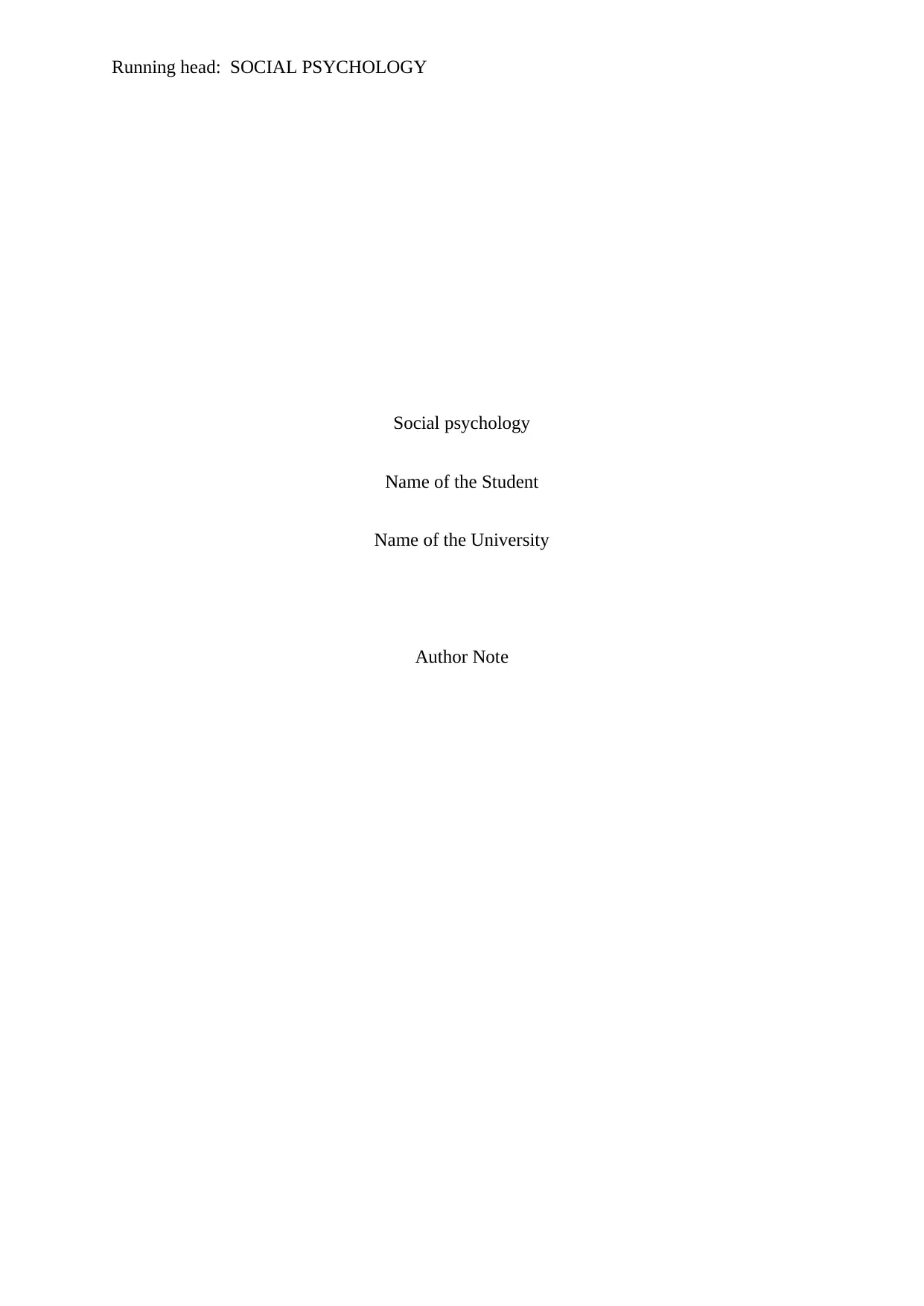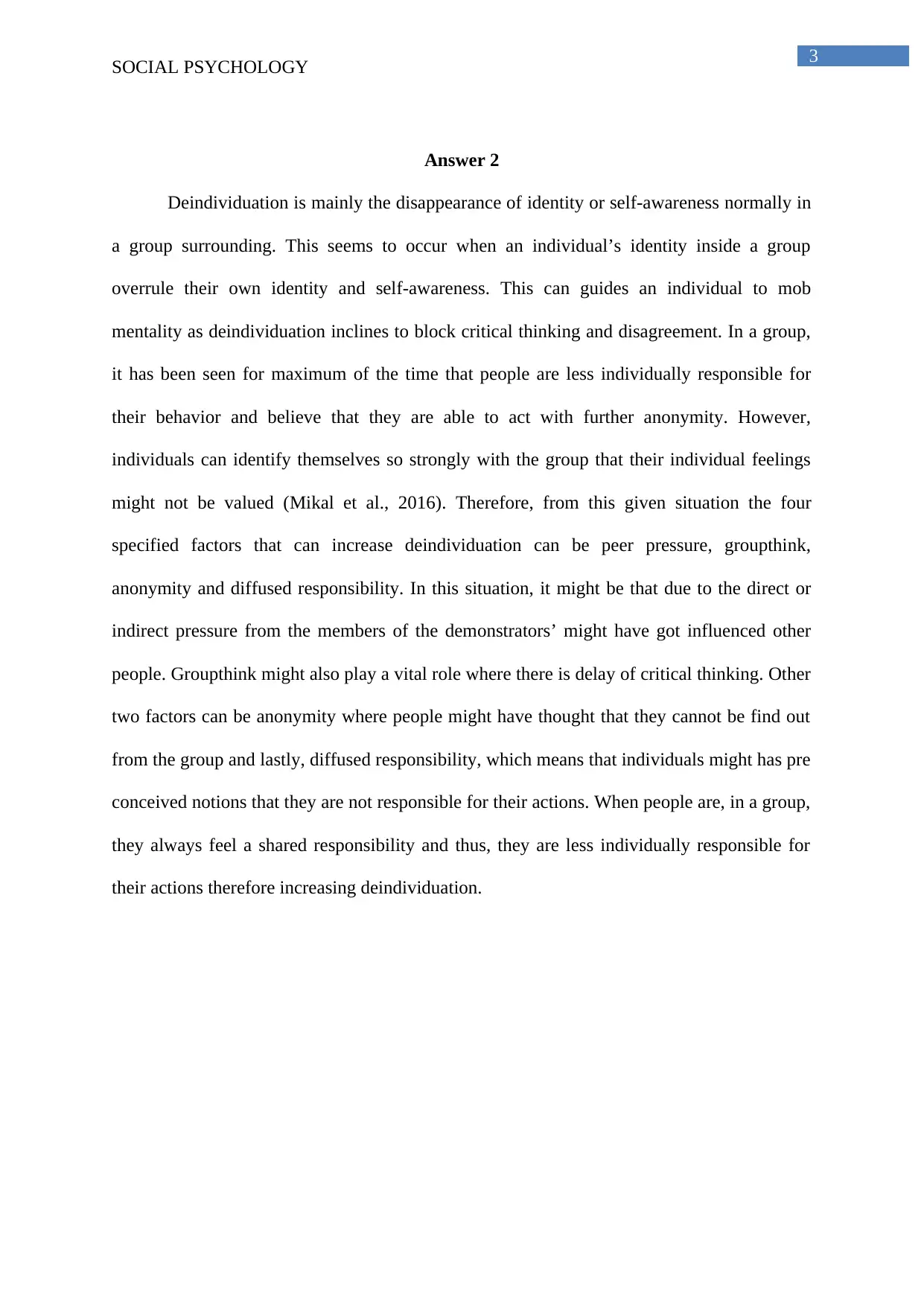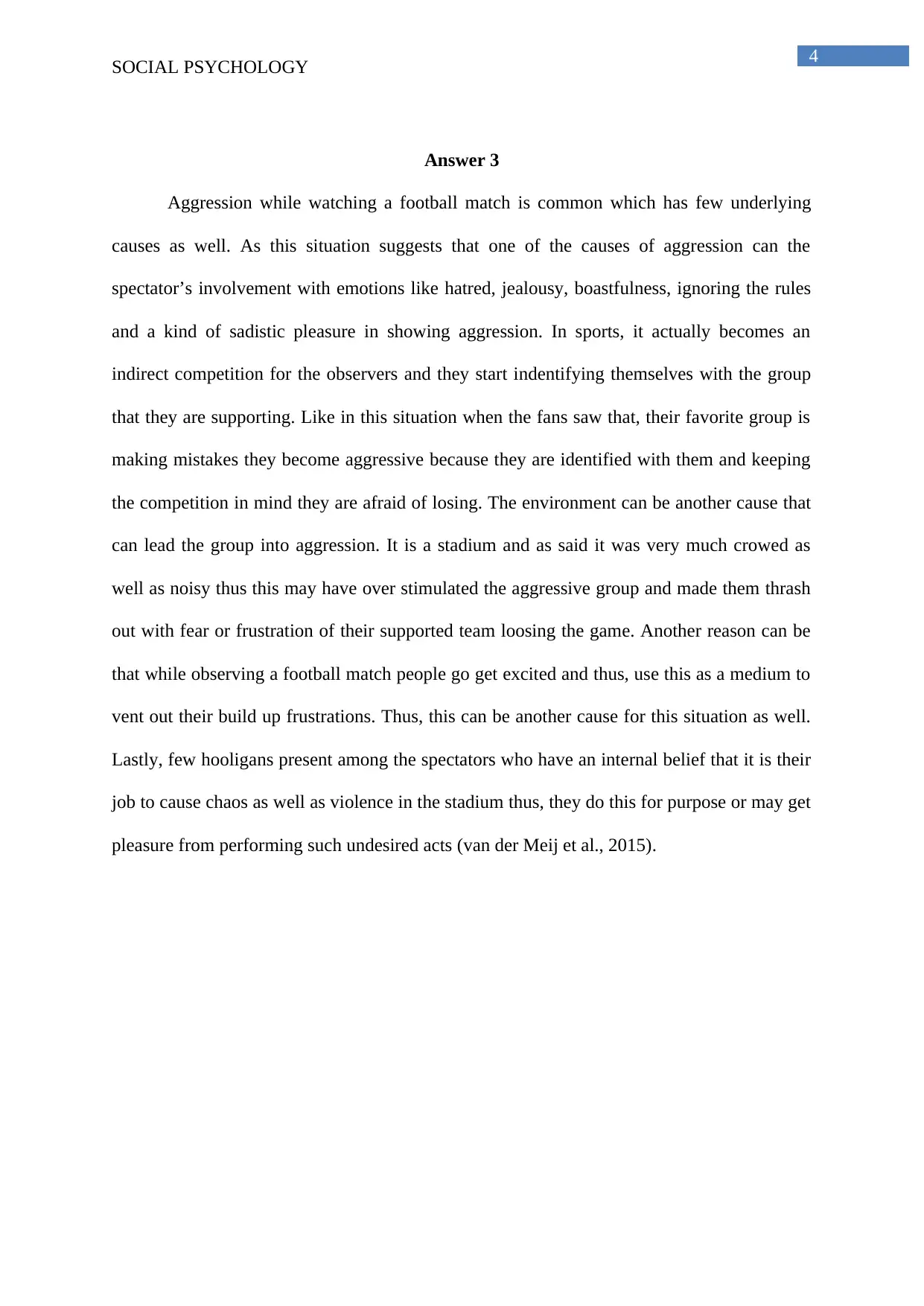Social Psychology: Exploring Group Behavior, Aggression, and Helping
VerifiedAdded on 2020/04/21
|7
|1336
|51
Homework Assignment
AI Summary
This social psychology assignment explores various aspects of human behavior within social contexts. The first answer analyzes factors influencing group decision-making, including the nature of the decision, experience, time constraints, confidentiality, and comfort zones, also discussing cognitive biases and individual differences. The second answer defines deindividuation, identifying factors like peer pressure, groupthink, anonymity, and diffused responsibility as contributors. The third answer examines aggression in the context of a football match, attributing it to spectator emotions, environmental factors, and the presence of hooligans. Finally, the fourth answer delves into the variables that influence people's willingness to help others, such as altruistic personality, social responsibility, empathy, moral reasoning, and gender differences. The assignment provides a comprehensive overview of key concepts in social psychology, offering insights into group dynamics, aggression, and prosocial behavior.

Running head: SOCIAL PSYCHOLOGY
Social psychology
Name of the Student
Name of the University
Author Note
Social psychology
Name of the Student
Name of the University
Author Note
Paraphrase This Document
Need a fresh take? Get an instant paraphrase of this document with our AI Paraphraser

1
SOCIAL PSYCHOLOGY
Table of Contents
Answer 1....................................................................................................................................2
Answer 2....................................................................................................................................3
Answer 3....................................................................................................................................4
Answer 4....................................................................................................................................5
References..................................................................................................................................6
SOCIAL PSYCHOLOGY
Table of Contents
Answer 1....................................................................................................................................2
Answer 2....................................................................................................................................3
Answer 3....................................................................................................................................4
Answer 4....................................................................................................................................5
References..................................................................................................................................6

2
SOCIAL PSYCHOLOGY
Answer 1
The five factors that might affect the decision making of a group are the nature of the
decision made, experience, availability of time, confidentiality and comfort zone. In a group
decision-making, the nature of the problem is a big factor that whether that will be consulted
with other or not. Here one might take the decision if the nature of the decision is not that
important where information needs to be sought from others. If there is previous, experience
of similar situations then information seeking and sharing might not place and one may use
his or her own mental models to predict what can happen and what needs to be done. Time is
another factor, which affect group decision making because if there is less time than taking
advices or suggestions gets restricted. An issue such as confidentiality inhibits the sharing of
information. Lastly, comfort zone is also affects group’s decision making, as here if the
leader is comfortable handling an issue from their comfort zone then why will they involve
others. Therefore, the groups will be built keeping in mind those factors that actually
influence the group decision-making to give the best output such as previous experiences, an
escalation of commitment, different cognitive biases and individual differences. If any
decision making in the past has positive result then people are more likely to decide in a
similar way. Cognitive biases are mainly thinking patterns that are based on the observations
and generalizations. However, people are inclined more to those decision making towards
which they feel more committed. Lastly, individual differences, which should be, keep in
mind as people of lower socio economic background will make poor decisions because of
their former decision-makings (Ford & Richardson, 2013).
SOCIAL PSYCHOLOGY
Answer 1
The five factors that might affect the decision making of a group are the nature of the
decision made, experience, availability of time, confidentiality and comfort zone. In a group
decision-making, the nature of the problem is a big factor that whether that will be consulted
with other or not. Here one might take the decision if the nature of the decision is not that
important where information needs to be sought from others. If there is previous, experience
of similar situations then information seeking and sharing might not place and one may use
his or her own mental models to predict what can happen and what needs to be done. Time is
another factor, which affect group decision making because if there is less time than taking
advices or suggestions gets restricted. An issue such as confidentiality inhibits the sharing of
information. Lastly, comfort zone is also affects group’s decision making, as here if the
leader is comfortable handling an issue from their comfort zone then why will they involve
others. Therefore, the groups will be built keeping in mind those factors that actually
influence the group decision-making to give the best output such as previous experiences, an
escalation of commitment, different cognitive biases and individual differences. If any
decision making in the past has positive result then people are more likely to decide in a
similar way. Cognitive biases are mainly thinking patterns that are based on the observations
and generalizations. However, people are inclined more to those decision making towards
which they feel more committed. Lastly, individual differences, which should be, keep in
mind as people of lower socio economic background will make poor decisions because of
their former decision-makings (Ford & Richardson, 2013).
⊘ This is a preview!⊘
Do you want full access?
Subscribe today to unlock all pages.

Trusted by 1+ million students worldwide

3
SOCIAL PSYCHOLOGY
Answer 2
Deindividuation is mainly the disappearance of identity or self-awareness normally in
a group surrounding. This seems to occur when an individual’s identity inside a group
overrule their own identity and self-awareness. This can guides an individual to mob
mentality as deindividuation inclines to block critical thinking and disagreement. In a group,
it has been seen for maximum of the time that people are less individually responsible for
their behavior and believe that they are able to act with further anonymity. However,
individuals can identify themselves so strongly with the group that their individual feelings
might not be valued (Mikal et al., 2016). Therefore, from this given situation the four
specified factors that can increase deindividuation can be peer pressure, groupthink,
anonymity and diffused responsibility. In this situation, it might be that due to the direct or
indirect pressure from the members of the demonstrators’ might have got influenced other
people. Groupthink might also play a vital role where there is delay of critical thinking. Other
two factors can be anonymity where people might have thought that they cannot be find out
from the group and lastly, diffused responsibility, which means that individuals might has pre
conceived notions that they are not responsible for their actions. When people are, in a group,
they always feel a shared responsibility and thus, they are less individually responsible for
their actions therefore increasing deindividuation.
SOCIAL PSYCHOLOGY
Answer 2
Deindividuation is mainly the disappearance of identity or self-awareness normally in
a group surrounding. This seems to occur when an individual’s identity inside a group
overrule their own identity and self-awareness. This can guides an individual to mob
mentality as deindividuation inclines to block critical thinking and disagreement. In a group,
it has been seen for maximum of the time that people are less individually responsible for
their behavior and believe that they are able to act with further anonymity. However,
individuals can identify themselves so strongly with the group that their individual feelings
might not be valued (Mikal et al., 2016). Therefore, from this given situation the four
specified factors that can increase deindividuation can be peer pressure, groupthink,
anonymity and diffused responsibility. In this situation, it might be that due to the direct or
indirect pressure from the members of the demonstrators’ might have got influenced other
people. Groupthink might also play a vital role where there is delay of critical thinking. Other
two factors can be anonymity where people might have thought that they cannot be find out
from the group and lastly, diffused responsibility, which means that individuals might has pre
conceived notions that they are not responsible for their actions. When people are, in a group,
they always feel a shared responsibility and thus, they are less individually responsible for
their actions therefore increasing deindividuation.
Paraphrase This Document
Need a fresh take? Get an instant paraphrase of this document with our AI Paraphraser

4
SOCIAL PSYCHOLOGY
Answer 3
Aggression while watching a football match is common which has few underlying
causes as well. As this situation suggests that one of the causes of aggression can the
spectator’s involvement with emotions like hatred, jealousy, boastfulness, ignoring the rules
and a kind of sadistic pleasure in showing aggression. In sports, it actually becomes an
indirect competition for the observers and they start indentifying themselves with the group
that they are supporting. Like in this situation when the fans saw that, their favorite group is
making mistakes they become aggressive because they are identified with them and keeping
the competition in mind they are afraid of losing. The environment can be another cause that
can lead the group into aggression. It is a stadium and as said it was very much crowed as
well as noisy thus this may have over stimulated the aggressive group and made them thrash
out with fear or frustration of their supported team loosing the game. Another reason can be
that while observing a football match people go get excited and thus, use this as a medium to
vent out their build up frustrations. Thus, this can be another cause for this situation as well.
Lastly, few hooligans present among the spectators who have an internal belief that it is their
job to cause chaos as well as violence in the stadium thus, they do this for purpose or may get
pleasure from performing such undesired acts (van der Meij et al., 2015).
SOCIAL PSYCHOLOGY
Answer 3
Aggression while watching a football match is common which has few underlying
causes as well. As this situation suggests that one of the causes of aggression can the
spectator’s involvement with emotions like hatred, jealousy, boastfulness, ignoring the rules
and a kind of sadistic pleasure in showing aggression. In sports, it actually becomes an
indirect competition for the observers and they start indentifying themselves with the group
that they are supporting. Like in this situation when the fans saw that, their favorite group is
making mistakes they become aggressive because they are identified with them and keeping
the competition in mind they are afraid of losing. The environment can be another cause that
can lead the group into aggression. It is a stadium and as said it was very much crowed as
well as noisy thus this may have over stimulated the aggressive group and made them thrash
out with fear or frustration of their supported team loosing the game. Another reason can be
that while observing a football match people go get excited and thus, use this as a medium to
vent out their build up frustrations. Thus, this can be another cause for this situation as well.
Lastly, few hooligans present among the spectators who have an internal belief that it is their
job to cause chaos as well as violence in the stadium thus, they do this for purpose or may get
pleasure from performing such undesired acts (van der Meij et al., 2015).

5
SOCIAL PSYCHOLOGY
Answer 4
The variables that determine people’s willingness to help others may include the
characteristics of the individuals who provide help to others as well, as how others while
helping them have responded them. The very first factor is the altruistic personality of some
people who are more helpful than others are. Personal variables do have a role to play that
influences the helping behavior in people thus, people who are more helpful than others
mainly have a prosocial or altruistic inbuilt personality (Beilin, 2013). The next factor can be
social responsibility, which influence people whether or not they will help others because if a
person is socially responsible then they will never think of taking advantage when a person is
in need. The next factor is empathy that is if people can perceive others need by putting
themselves in their current situation then helping them will be easier. Thus, empathy also
plays a vital role where it influences people’s helping behavior. Then there is moral reasoning
where the decision of whether to help others or not are totally based on the concern for other
individuals. Moral reasoning is the way people think about the fair and appropriate way
through which they must act to help others. Lastly, another factor is gender differences. In
situations where there is more need for physical help there; men are more inclined to help
than women do. Women are more helpful in a situation, which requires long term caring and
nurturance within close relationships.
SOCIAL PSYCHOLOGY
Answer 4
The variables that determine people’s willingness to help others may include the
characteristics of the individuals who provide help to others as well, as how others while
helping them have responded them. The very first factor is the altruistic personality of some
people who are more helpful than others are. Personal variables do have a role to play that
influences the helping behavior in people thus, people who are more helpful than others
mainly have a prosocial or altruistic inbuilt personality (Beilin, 2013). The next factor can be
social responsibility, which influence people whether or not they will help others because if a
person is socially responsible then they will never think of taking advantage when a person is
in need. The next factor is empathy that is if people can perceive others need by putting
themselves in their current situation then helping them will be easier. Thus, empathy also
plays a vital role where it influences people’s helping behavior. Then there is moral reasoning
where the decision of whether to help others or not are totally based on the concern for other
individuals. Moral reasoning is the way people think about the fair and appropriate way
through which they must act to help others. Lastly, another factor is gender differences. In
situations where there is more need for physical help there; men are more inclined to help
than women do. Women are more helpful in a situation, which requires long term caring and
nurturance within close relationships.
⊘ This is a preview!⊘
Do you want full access?
Subscribe today to unlock all pages.

Trusted by 1+ million students worldwide

6
SOCIAL PSYCHOLOGY
References
Beilin, H. (2013). The development of prosocial behavior. Academic Press.
Ford, R. C., & Richardson, W. D. (2013). Ethical decision making: A review of the empirical
literature. In Citation classics from the Journal of Business Ethics (pp. 19-44).
Springer Netherlands.
Mikal, J. P., Rice, R. E., Kent, R. G., & Uchino, B. N. (2016). 100 million strong: A case
study of group identification and deindividuation on Imgur. com. new media &
society, 18(11), 2485-2506.
van der Meij, L., Klauke, F., Moore, H. L., Ludwig, Y. S., Almela, M., & van Lange, P. A.
(2015). Football Fan aggression: the importance of low basal cortisol and a fair
referee. PloS one, 10(4), e0120103.
SOCIAL PSYCHOLOGY
References
Beilin, H. (2013). The development of prosocial behavior. Academic Press.
Ford, R. C., & Richardson, W. D. (2013). Ethical decision making: A review of the empirical
literature. In Citation classics from the Journal of Business Ethics (pp. 19-44).
Springer Netherlands.
Mikal, J. P., Rice, R. E., Kent, R. G., & Uchino, B. N. (2016). 100 million strong: A case
study of group identification and deindividuation on Imgur. com. new media &
society, 18(11), 2485-2506.
van der Meij, L., Klauke, F., Moore, H. L., Ludwig, Y. S., Almela, M., & van Lange, P. A.
(2015). Football Fan aggression: the importance of low basal cortisol and a fair
referee. PloS one, 10(4), e0120103.
1 out of 7